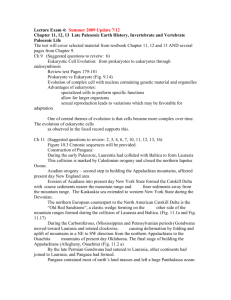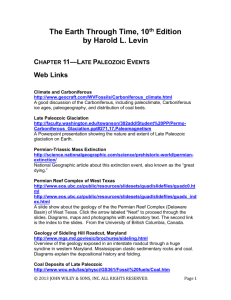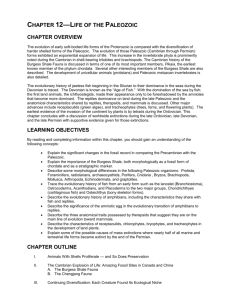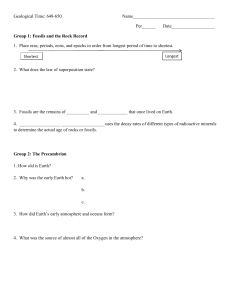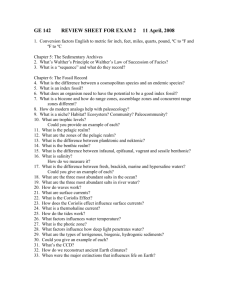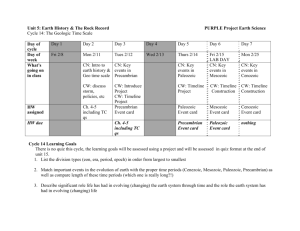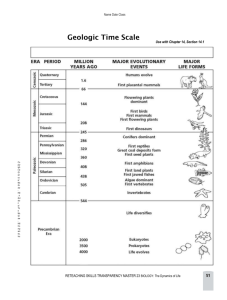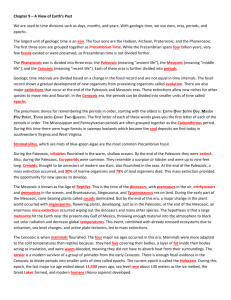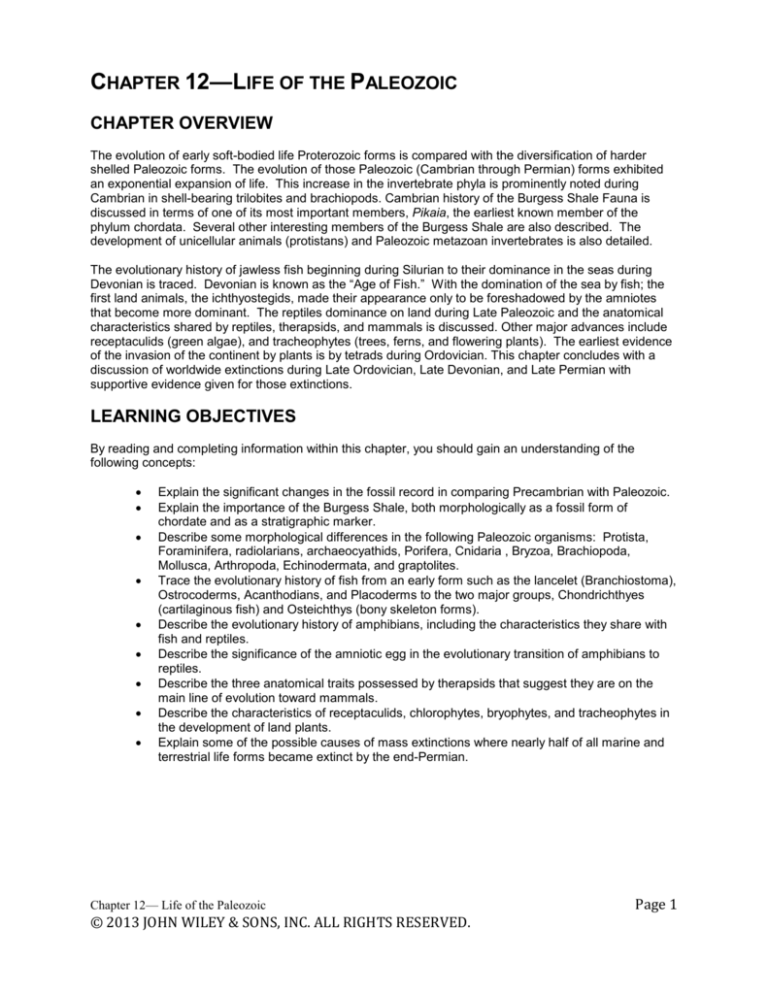
CHAPTER 12—LIFE OF THE PALEOZOIC
CHAPTER OVERVIEW
The evolution of early soft-bodied life Proterozoic forms is compared with the diversification of harder
shelled Paleozoic forms. The evolution of those Paleozoic (Cambrian through Permian) forms exhibited
an exponential expansion of life. This increase in the invertebrate phyla is prominently noted during
Cambrian in shell-bearing trilobites and brachiopods. Cambrian history of the Burgess Shale Fauna is
discussed in terms of one of its most important members, Pikaia, the earliest known member of the
phylum chordata. Several other interesting members of the Burgess Shale are also described. The
development of unicellular animals (protistans) and Paleozoic metazoan invertebrates is also detailed.
The evolutionary history of jawless fish beginning during Silurian to their dominance in the seas during
Devonian is traced. Devonian is known as the “Age of Fish.” With the domination of the sea by fish; the
first land animals, the ichthyostegids, made their appearance only to be foreshadowed by the amniotes
that become more dominant. The reptiles dominance on land during Late Paleozoic and the anatomical
characteristics shared by reptiles, therapsids, and mammals is discussed. Other major advances include
receptaculids (green algae), and tracheophytes (trees, ferns, and flowering plants). The earliest evidence
of the invasion of the continent by plants is by tetrads during Ordovician. This chapter concludes with a
discussion of worldwide extinctions during Late Ordovician, Late Devonian, and Late Permian with
supportive evidence given for those extinctions.
LEARNING OBJECTIVES
By reading and completing information within this chapter, you should gain an understanding of the
following concepts:
Explain the significant changes in the fossil record in comparing Precambrian with Paleozoic.
Explain the importance of the Burgess Shale, both morphologically as a fossil form of
chordate and as a stratigraphic marker.
Describe some morphological differences in the following Paleozoic organisms: Protista,
Foraminifera, radiolarians, archaeocyathids, Porifera, Cnidaria , Bryzoa, Brachiopoda,
Mollusca, Arthropoda, Echinodermata, and graptolites.
Trace the evolutionary history of fish from an early form such as the lancelet (Branchiostoma),
Ostrocoderms, Acanthodians, and Placoderms to the two major groups, Chondrichthyes
(cartilaginous fish) and Osteichthys (bony skeleton forms).
Describe the evolutionary history of amphibians, including the characteristics they share with
fish and reptiles.
Describe the significance of the amniotic egg in the evolutionary transition of amphibians to
reptiles.
Describe the three anatomical traits possessed by therapsids that suggest they are on the
main line of evolution toward mammals.
Describe the characteristics of receptaculids, chlorophytes, bryophytes, and tracheophytes in
the development of land plants.
Explain some of the possible causes of mass extinctions where nearly half of all marine and
terrestrial life forms became extinct by the end-Permian.
Chapter 12— Life of the Paleozoic
© 2013 JOHN WILEY & SONS, INC. ALL RIGHTS RESERVED.
Page 1
CHAPTER OUTLINE
I.
Animals With Shells Proliferate — and So Does Preservation
II.
The Cambrian Explosion of Life: Amazing Fossil Sites in Canada and China
A. The Burgess Shale Fauna
B. The Chengjang Fauna
III.
Continuing Diversification: Each Creature Found Its Ecological Niche
IV.
Protistans: Creatures of a Single Cell
A. Foraminifera
B. Radiolaria
V.
Marine Invertebrates Populate the Seas
A. Cup Animals: Archaeocyathids
B. Sponges: Phylum Porifera
C. Corals and Other Cnidaria
D. Moss Animals: Bryozoa
E. Brachiopods
F. Mollusks: Clams, Snails, Squid, and Kin
G. Arthropods: Jointed Bodies and Limbs
H. Spiny-Skinned Animals: Echinoderms
I. The Echinoderm-Backbone Connection
J. Graptolites
VI.
Advent of the Vertebrates
VII.
The Rise of Fishes
A. Agnathids (Jawless Fish)
B. Evolution of the Jaw
C. Acanthodians and Placoderms (Fish with Jaws)
D. Chondrichthyes (Fish with Cartilaginous Skeletons)
E. Osteichthyes (Fish with Bony Skeletons)
VIII.
Conodonts: Valuable but Enigmatic Fossils
IX.
Advent of Tetrapods
A. Coming Ashore: First Four-Legged Vertebrates
B. Amniotes: Reptiles, Birds, and Mammals
X.
Plants of the Paleozoic
A. Land Plants
XI.
Mass Extinctions
A. Late Ordovician Extinctions
B. Late Devonian Extinctions
C. Late Permian Extinctions — Terrestrial Causes?
D. Late Permian Extinctions — Extraterrestrial Cause?
Chapter 11— Late Paleozoic Events
© 2013 JOHN WILEY & SONS, INC. ALL RIGHTS RESERVED.
Page 2
KEY TERMS
(pages given in parentheses)
acanthodians (366): The earliest known vertebrates (fishes) with a movable, well-developed lower jaw,
or mandible; hence, the first jawed fishes.
actinopterygian fish(366): A division of bony fish—ray—fin forms. They lack a muscular base to their
paired fins which are thin structures supported by radiating rods or rays. They also lack paired nasal
passages that open into the throat.
Agnathans (364): Early agnathids are collectively termed ostracoderms (“shell skins”). The oldest
armored forms were present during Paleozoic. Some lacked heavy bony armor. The diverse forms also
include unarmored forms.
ammonoid (351): An extinct group (subclass) of cephalopods, with coiled, chambered conch(s) and
having septa with crenulated margins.
amniotic egg (337): Egg produced by reptiles, birds, and monotremes in which the developing embryo is
protected by an elaborate arrangement of shell membranes, yolk sac, amnion, and allantois.
amniotic membrane (363): Membrane which allows oxygen to enter but which retains water. The
membrane encloses the embryo in a cushioning, watery environment.
amniotic vertebrate (363): Higher vertebrates that have evolved internal fertilization and an amniotic egg.
antiarch (363): A heavily armored placoderm that had mud-grubbing habits.
archaeocyathid (345): A group of extinct marine organisms having double, perforated, calcareous,
conical-to-cylindrical walls. Archaeocyathids lived during Cambrian.
arthrodire (366): (Latin: jointed neck.) The name refers to a ball-and-socket joint between shoulder and
head that allowed the head to be rotated backward. A member of the placoderms; arthrodires were the
most formable of the plate-skinned fish that were carnivorous.
arthropod (351): An enormous phylum that includes such living animals as lobsters, spiders, insects,
and a host of other animals that possess chitinous exterior skeletons, segmented bodies, paired and
jointed appendages, and highly developed nervous systems and sensory organs. Members of arthropoda
that have left a particularly significant fossil record are the trilobites, ostracods, and eurypterids.
asteroidea (356): A member of phylum Echinodermata that are abundant and useful in geologic studies.
Includes the starfish.
basal tetrapod (337): Includes amphibians. Basal tetrapod is a term applied to the earliest four-legged
amphibians that walked on land, inhabited lakes, streams, and laid eggs that survived only in water.
bioturbation (343): The disturbance of sediment by burrowing, boring, and sediment-ingesting
organisms.
Bivalvia (Pelcypoda) (350): Class of mollusks which includes clams, oysters, and mussels. They are
characterized by layered gills, a muscular foot, a bi-lobed mantle, and the absence of a definite “head.”
Members of the class made their first appearance during Cambrian, but did not become notably abundant
until Pennsylvanian and Permian when they populated the shallow seas of the time.
Blastoidea (356): Sessile (attached) Paleozoic echinoderms having a stem and an attached cup or calyx
composed of relatively few plates.
Chapter 11— Late Paleozoic Events
© 2013 JOHN WILEY & SONS, INC. ALL RIGHTS RESERVED.
Page 3
blastopore (359): A group of cells that form inward on the blastula to form an opening called the
blastopore. In echinoderms and chordates the blastopore develops into the anus.
blastula (359): In the early development of a chordate and echinoderm embryo a small sphere of cells
that are formed.
brachiopod (348): Bivalved (double-shelled) marine invertebrates. They were particularly common and
widespread during Paleozoic and persist in fewer numbers today.
bryophyte (375): Today’s land plants that include mosses, liverworts, and hornworts.
bryozoan (347): A phylum of attached and incrusting colonial marine invertebrates. Minute, bilaterally
symmetric animals that grow in colonies, which frequently appear twig-like when viewed without the aid of
a magnifier.
Burgess Shale fauna (338): Exposure that contains one of the most important faunas in the fossil
record. The fossils in the Burgess Shale are reduced to shiny, jet like impressions on the bedding planes
of the black rock. Most of them are the remains of animals that lacked shells. Altogether, they form an
extraordinary assemblage that includes four major groups of arthropods (trilobites, crustaceans, and
members of the taxonomic groups that include scorpions and insects) as well as sponges, onycophorans,
crinoids, sea cucumbers, chordates, and many species that defy placement in any known phyla.
cephalopod (350): May be the most complex of all the mollusks. This marine group is represented by
the squid, cuttlefish, octopod, and the attractive chambered nautilus.
ceratite (351): One of the three larger groups of ammonoid cephalopods having sutural complexity,
intermediate between goniates and ammonites.
Chengjian fauna (343): A fauna that resembles that of the Burgess Shale, but that are older and better
preserved. Many of the normally soft-bodied worms, eyes, segmentation, digestive organs are preserved.
The Chengjiang fossils are dated at 535 million years old. They also include the world’s oldest fish.
chlorophyte (374): Green algae. The close relationship between chlorophytes and land plants is
suggested by their adaptation not only to freshwater bodies but to moist soil as well. Both green algae and
land plants possess the same kind of green pigments and produce the same kind of carbohydrate during
photosynthesis. During Early Paleozoic, chlorophytes were probably symbiotically joined by fungi to form
lichens.
chordate (342): Are unique creatures that in some stages in their development, have a notochord (an
internal supportive rod) and a nerve cord that extend along the dorsal (upper) side of the notochord. In
humans, the notochord is replaced with a series of vertebrae, therefore are called vertebrates.
Cnidaria (346): A phylum including sea anemones, sea fans, jellyfish, the tiny Hydra, and reef-forming
corals. This phylum is known for the great diversity and beauty of its members. The body wall is
composed of an outer layer of cells, the ectoderm; and inner layer, the endoderm; and a thin, non-cellular
intermediate layer, the mesoglea.
cnidocyte (347): Members of Cnidaria have stinging cells (cnidophytes) that when activated can inject a
paralyzing poison, e.g., jelly fish.
conodont elements (370): Small, tooth-like fossils composed of calcium phosphate and found in rocks
ranging from Cambrian to Triassic. Although the precise nature of the conodont-producing organism has
not been determined, this uncertainty does not detract from their usefulness as guide fossils.
Chapter 11— Late Paleozoic Events
© 2013 JOHN WILEY & SONS, INC. ALL RIGHTS RESERVED.
Page 4
crinoid (357): Stalked echinoderm with a calyx composed of regularly-arranged plates from which radiate
arms for gathering food.
crinoid (357): Crinoids are the most abundant stalked echinoderm. They range from Cambrian to
present. Some Ordovician, Silurian, and Carboniferous limestones contain such great quantities of crinoid
plates that they are called “crinoidal limestones.”
Crinoidea (356): One of the many classes of the phylum Echinodermata. Stalked echinoderms, usually
called crinoids.
crossopterygian fish (370): That group of choanichthyan fishes ancestral to earliest amphibians and
characterized by stout pectoral and pelvic fins as well as lungs.
deuterostome (359): Echnoderms and chordates are deuterostomes since they form an anus from an
opening called a blastopore.
Diploporita (356): One of the many classes of the phylum Echinodermata. These echinoderms have
unusual patterns of pores.
dipnoan fish (367): An order of lungfishes with weak pectoral and pelvic fins; not considered ancestral to
land vertebrates.
echinoderm (356): The large group (phylum Echinodermata) of marine invertebrates characterized by
prominent pentamerous symmetry and skeleton frequently constructed of calcite elements including
spines. Cystoids, blastoids, crinoids, and echinoids are examples of echinoderms.
Echinoidea (356): Class of the phylum Echinodermata which includes sea urchins. Echinoids were more
frequent in later eras.
Edrioasteroid (356): Class of the phylum Echinodermata. Edrioasteroids are considered to be ancestral
to starfish and sea urchins.
epifaunal animal (343): Organisms living on, as distinct from in, a particular body of sediment or another
organism. They live on top of the sediment that carpets the seafloor.
eurypterid (355): Aquatic Paleozoic arthropods, superficially resembling scorpions, and probably
carnivorous.
filter feeders (343): Organisms that strained tiny bits of organic matter or microorganisms from the water.
foraminifera (343): An order of mostly marine, unicellular protozoans that secrete tests (shells) that are
usually composed of calcium carbonate.
fusulinid (343): Primarily spindle-shaped foraminifers with calcareous, coiled tests divided into a
complex of numerous chambers. Fusulinids were particularly abundant during Pennsylvanian and
Permian.
gastropod (350): Class of mollusk first appearing in Lower Cambrian strata. The earliest forms
constructed small, depressed conical shells. During Late Cambrian and Ordovician, gastropods with the
more familiar coiled conchs became commonplace. By Pennsylvanian, gastropods had become abundant
and diverse. The oldest known air-breathing (pulmonate) gastropods appeared. Permian ended with
widespread extinctions among marine invertebrates, and many families of gastropods were decimated.
goniatite (351): One of the three large groups of ammonoid cephalopods with sutures forming a pattern
of simple lobes and saddles and thus not as complex as either the ceratites or the ammonites.
Chapter 11— Late Paleozoic Events
© 2013 JOHN WILEY & SONS, INC. ALL RIGHTS RESERVED.
Page 5
graptolite (361): Extinct colonial marine invertebrates considered to be protochordates. Graptolites
range from Late Cambrian to Mississippian.
herbivore (343): Animals that consume plants exclusively.
HOX genes (338): Sequences of genes that control the development of entire regions of the body.
They lay out the basic body architecture of many animals. Very small changes in HOX genes are
potentially able to cause sudden and major evolutionary change.
hypercapnia (380): Carbon dioxide poisoning.
ichthyostegid (372): The fossil record for amphibians begins with this group. These creatures retained
many features of their fish ancestors.
infaunal animal (343): Organisms that live and feed within bottom sediments. They burrow into soft
sediment for food and protection.
labyrinthodont (372): Amphibians that followed the ichthyostegids fall within a group termed
labyrinthodonts. During Carboniferous, large numbers of labyrinthodonts walled in swamps and streams,
eating insects, fish, and one another. A labyrinthodont that exemplifies the culmination of the lineage is
Eryops. Labyrinthodonts declined during Permian, and only a relatively few survived into Triassic.
lycopsid (375): Leafy plants with simple, closely spaced leaves bearing sporangia on their upper
surfaces. They are represented by living club mosses and vast numbers of extinct Late Paleozoic “scale
trees.”
mass extinctions (337): Marked by times of sudden worldwide extinctions of large number of animals
and some plant populations. During Paleozoic, mass extensions occurred during Late Ordovician,
Devonian, and Permian.
mollusk (349): Any member of the invertebrate Phylum Mullusca, including bivalves (pelecypods)
cephalopods, gastropods, scaphopods, and chitons.
monoplacophoran (349): Primitive marine molluscans with simple, cap-shaped shells.
nautiloid (351): A subclass of cephalopods having straight or gently undulating sutures.
non-amniotic vertebrates (363):
notochord (342): A rod-shaped cord of cartilage cells forming the primary axial structure of the chordate
body. In vertebrates, the notochord is present in the embryo and is later supplanted by the vertebral
column.
Ophiuroidea (356): A member of Phylum Echinodermata. Class Ophiuroidea include brittle stars.
osteichthyes (365): Are the bony fish forms that represent the most numerous, varied and successful of
all aquatic vertebrates. They also play a key role in the evolution of testrapods (four-legged animals).
ostracod (355): Bean-shaped arthropod of Paleozoic seas. They are bivalved resembling a small clam.
The bivalved carapace encloses a segmented body from which extend seven pairs of jointed
appendages. Valves are composed of both chitin and calcium carbonate and are hinged along the dorsal
margin. Ostracods first appeared during Early Ordovician and continue in relative abundance to the
present day. They occur in both marine and freshwater sediments.
Chapter 11— Late Paleozoic Events
© 2013 JOHN WILEY & SONS, INC. ALL RIGHTS RESERVED.
Page 6
ostracoderm (365): Extinct jawless fishes of Early Paleozoic.
Pelecypoda (350): A class of mollusks that includes clams, mussels, scallops, and oysters. They
originated during Cambrian, but did not become abundant until Carboniferous and Permian.
pelycosaur (372): These Permian reptiles had several mammalian skeletal characteristics, they are
thought to be early representatives of the reptilian group which advanced, mammal-like reptiles known as
therapsids arose.
placoderm (366): Extinct primitive Paleozoic jawed fishes.
placophoran (349): Relatively primitive mollusks that have multiple-paired gills and, in shelled forms, a
creeping foot much like that seen in snails. The most familiar is the polyplacophorans, represented by
chitons, which possess eight overlapping plates covering an ovoid, flattened body.
polyplacophorans (349): Are primitive mollusks that have multiple-paired gills and, in shelled forms, a
creeping foot similar to snails. Chitons are polyplcophorans. Their fossil record extends from Cambrian to
present.
Porifera (345): Phylum containing sponges. Sponges appear to have evolved from colonial flagellated
unicellular creatures and thus provide insight into how the transition from unicellular to multicellular
animals may have occurred. Sponges have always been predominantly marine creatures, although a few
modern species live in fresh water. Although sponges vary greatly in size and shape, their basic structure
is that of a highly perforated vase modified by folds and canals. The body is attached to the seafloor at
the base, and there is an excurrent opening, or osculum, at the top. The walls consist of two layers of
cells. Facing the internal space is a layer of collar cells (choanocytes), and on the outside is a protective
wall of flat cells that resemble the bricks of a worn masonry pavement. Between these two layers one
finds a gelatinous substance called mesenchyme. Sponges lack true organs. Water currents moving
through the sponge are created by the beat of flagellae. The currents bring in suspended food particles,
which are ingested by the collar cells. In a simple sponge, water enters through the pores, flows across
sheets of choanocytes in the central cavity, and passes out through the osculum.
protostome (359): Animals that would include arthropods, mollusks, and annelid worms in which the
blastopore develops into a mouth.
pterobranchs (362): A primitive living chardate that secretes tiny enclosed tubes.
radiolaria (344): Protozoa that secrete a delicate, often beautifully filigreed skeleton of opaline silica.
receptaculid (374): Relatively common group of marine algal fossils found within Lower Paleozoic rocks.
Receptaculids are lime-secreting green algae of the family Dasycladaea. Although most frequently found
within Ordovician rocks, members of this group also occur sparsely within Silurian and Devonian strata.
sarcopterygian fish (366): Lobe-finned bony fish including air-breathing crossopterygion fish that had a
pair of openings in the roof of the mouth that led to external nostrils. This allowed sarcopterygion to rise to
the surface and take in air. This eventually led to functional lungs.
sediment feeders (343): Organisms that ingest mud of the seafloor through their digestive tracts to
extract nutrients, as earthworms today.
small shelly fossils (337): Fossils that date back to Late Neoproterozoic. Include shells and skeletal
elements of mollusks and sponges. It also includes small invertebrates of uncertain classification that
secreted tabular or cap-shaped shells.
Chapter 11— Late Paleozoic Events
© 2013 JOHN WILEY & SONS, INC. ALL RIGHTS RESERVED.
Page 7
stromatoporoid (345): A group of Early Paleozoic sclerosponges of particular interest because of their
reef-building capabilities. These organisms constructed fibrous, calcareous skeletons of pillars and thin
laminae that can nearly always be found in reef-associated Silurian and Devonian carbonate rocks.
synapsid (372): Reptiles having only one temporal opening which is located low on the skull (below the
squamosal and post orbital bones): belongs to the subclass Synapsida.
tetrapod (337, 363): Vertebrates that include both water-dwelling and land-dwelling forms that walk on
four legs.
therapsid (337, 374): An order of advanced mammal-like reptiles. They were widely dispersed during
Permian and Triassic. They were predominantly small to moderate-sized animals that displayed at least
the beginnings of several mammalian skeletal traits. There were fewer bones in the skull than generally
found in reptile skulls, and there was a mammal-like enlargement of the lower jaw bone (dentary) at the
expense of more posterior elements of the jaw. A double ball-and-socket articulation had evolved
between the skull and neck. Teeth showed a primitive but distinct differentiation into incisors, canines and
cheek teeth. The limbs were in more direct vertical alignment beneath the body, and the ribs were
reduced in the neck and lumbar region for greater overall flexibility. Therapsids became extinct early in
the Jurassic. Before they died out, they gave origin to the early mammals.
tracheophyte (375): A member of today’s land plants includes trees, ferns, and flowing plants.
Tracheophytes have a vascular tissue that transports water and nutrients from one part of the plant to
another.
trilobite (351): Swimming or crawling arthropods that take their name from division of the dorsal surface
into three longitudinal segments, or lobes. The skeleton was composed of chitin strengthened by calcium
carbonate in parts not requiring flexibility. Growth was accomplished by molting. Although many trilobites
were sightless, the majority had either single-lens eyes or compound eyes composed of a large number of
discrete visual bodies. Earliest forms had small pygidian and a large number of thoracic segments
suggesting evolution from annelid worms.
vertebral column (363): The segmented backbone of the vertebral animal.
vertebrate (342, 358): Animals having a segmented backbone, or dorsal vertebrae column. The vertebral
column is composed of individual vertebrae. Arches of the vertebrae encircle and protect a hollow spinal
cord (nerve cord). In addition, vertebrates have a cranium or skull that houses a brain.
water vascular system (356): A system possessed by phylum Echinodermata in which a system of softtissue tubes function in respiration and locomotion.
Chapter 11— Late Paleozoic Events
© 2013 JOHN WILEY & SONS, INC. ALL RIGHTS RESERVED.
Page 8
MULTIPLE-CHOICE QUESTIONS
1.
Tracheophytes, which have vascular tissues that provide for transport of water and nutrients,
include
a. ctenophora, cnidocytes, chidara.
c. archaeocyathids, stromotopoids.
b. mosses, liverworts, hornworts.
d. trees, ferns, flowering plants.
2.
The common group of marine algal fossils found in Lower Paleozoic rocks are lime-secreting green
algae that resemble the seed-bearing part of a sunflower called
a. stromatotites.
c. chlorphytes.
b. receptaculids.
d. psilophytes.
3.
The type of unicellar animal that builds its tiny shells (tests) by adding chambers singly, in rows, in
coils, or in spiral is called
a. foraminifers.
c. archaeocyathids.
b. radiolarians.
d. cnidaria.
4.
The earliest abundant reef-building animals constructed conical cup or vase-shaped skeletons from
calcium carbonate and are useful in the stratigraphic correlation of lower and middle centurion strata
are called
a. archaeocyathids.
c. pore-bearers.
b. unicellular animals.
d. porifera.
5.
Sea anemones, sea fans, jellyfish, the tiny Hydra, and reef-forming corals are all representatives of
the phylum
a. Ctenophora.
c. Conodonta.
b. Chidocytes.
d. Cnidaria.
6.
Minute, bilaterally symmetric animals that grow in colonies and frequently appear as crusts or twiglike branches when viewed without the aid of a magnifier are termed
a. Bryozoans.
c. Cnidaria.
b. Tabulae.
d. Corals.
7.
The group that is probably the most abundant, diverse, and useful fossil found in Paleozoic rocks,
characterized by a pair of enclosing valves, which together constitute the shell of the animal is called
a. anthropod.
c. gastropod.
b. brachiopod.
d. cephalopod.
8.
The fusulinids are among the most important invertebrate guide fossils of which spans of geological
time?
a. Ordovician
c. Mississippian
b. Pennsylvanian to Permian
d. Devonian to Permian
9.
The group of planktic, colonial, marine organisms that had skeletons made from chitin and housed
colonies of tiny individual organisms are called
a. Trilobites.
c. Conodonts.
b. Blastoids.
d. Graptolites.
10.
One of the characteristics of chordates is the presence of what feature in some stage of their
development?
a. skeleton
c. gills
b. notochord
d. differentiated muscles
Chapter 11— Late Paleozoic Events
© 2013 JOHN WILEY & SONS, INC. ALL RIGHTS RESERVED.
Page 9
11.
The Cambrian animal, Pikaia, of the Burgess Shale is important because it
a. represents the first animals to develop appendages.
b. was the oldest known Chordata.
c. shared characteristics with Cnidaria.
d. defies any similarity to any forms known on Earth today.
12.
The class of mollusca which includes clams, oysters, and mussels is called
a. brachiopod.
c. bivalva (pelecypod).
b. gastropod.
d. cephalopod.
13.
Members of this exclusively marine phylum that possess a five-way symmetry that masks an
underlying primitive bilateral symmetry are called
a. Cnidaria.
c. Porifera.
b. Echinodermata.
d. bivalva.
14.
The oldest fossil remains of jawless fish that are found in Lower Paleozoic rocks are called
a. placoderms.
c. ostracoderms (Agnatha).
b. acanthodians.
d. branchiostomas.
15.
The first heavily armored jawed fish that was also called “plate-skinned” fishes is a(n)
a. labyrinthodont.
c. dipnoan.
b. ostracoderm.
d. placoderm.
16.
The category of bony fishes characterized by sturdy, fleshy lobefins, and a pair of openings in the
roof of the mouth that led to clearly visible nostrils is called
a. sarcopterygii.
c. ostracoderms.
b. ichthyistegids.
d. placoderms.
17.
Late Paleozoic amphibians, whose teeth enamel is characterized by complex wrinkling and folding,
are called the
a. crossopterygians.
c. pelycosaurs.
b. labyrinthodonts.
d. lycopsids.
18.
The dominant Permian reptile group that had several mammalian skeletal traits was the
a. Placoderms.
c. Ichthyostegids.
b. Archaeocyathids.
d. Therapsids.
19.
The phylum that includes shell-bearing invertebrates including bivalves (clams, oysters), snails,
chambered nautilus and octopods is called
a. Chidaria.
d. Arthropods.
b. Brachiopoda.
e. Mollusca.
c. Echinodermata
20.
The amniotic egg freed tetrapids from their reproductive dependency on water bodies. One of the
earliest Permian amniotes was
a. Crossopterygian.
c. Therapsid.
b. Ishthyostega.
d. Cacops.
Chapter 11— Late Paleozoic Events
© 2013 JOHN WILEY & SONS, INC. ALL RIGHTS RESERVED.
Page 10
FILL IN THE BLANK
1.
The group of plants that includes trees, ferns, and flowering plants and has vascular tissues that
provide for transport of water and nutrients is called
.
2.
The member of the lycopsid tree group called scale trees, which was a species with elongated
leaves that emerged directly from the trunks and branches and when released, left a pattern of
diagonal spirals was called
.
3.
The widely-known seed fern that was restricted to the southern hemisphere during Carboniferous
and Permian and possessed thick, tongue-shaped leaves was called
4.
One of the earliest Cambrian assemblages of fossils found near Mount Wapta, British Columbia
was called the
Shale.
5.
The animals that have at some stage in their development or throughout their lives, a notochord and
a dorsally set nerve chord are called
.
6.
Minute, bilaterally symmetric animals which grow in colonies and frequently appear twig-like when
viewed without the aid of a magnifier are
.
7.
The algal group most likely to have begun the progression toward complex land plants was the
____________________________________.
8.
The group of invertebrates that represents the most abundant, diverse and useful fossils readily
found in Paleozoic rocks is called
.
9.
Reef-forming corals, sea anemones, sea fans, jellyfish and Hydra are members of the phylum
called
.
10.
Members of phylum mollusca that include clams, oysters and mussels can be termed pelecypods or
.
11.
The Early Cambrian form of phylum Arthropoda that left an excellent fossil record and whose body
is divided into a cephalon, thorax, and pygidium is called
.
12.
The earliest Paleozoic jawless fish are called agnatha (jawless) and as a group are collectively
called
.
13.
The group of amphibians that followed the ichthyostegids and are named for the wrinkling and
folding of their tooth enamel are called
.
14.
Because pelycosaurs had skeletal characteristics similar to mammals they are thought to have
given rise to the more advanced mammal-like reptiles called
15.
.
.
Shell-bearing foraminifera that resemble wheat grains are called __________________.
Chapter 11— Late Paleozoic Events
© 2013 JOHN WILEY & SONS, INC. ALL RIGHTS RESERVED.
Page 11
TRUE-FALSE
1.
The Burgess Shale contains one of the most important fossil assemblages of the
Cambrian.
2.
Receptaculids are lime-secreting green algae of the family Dasycladaea.
3.
The ostracoderms are the first armored, jawless fish.
4.
Foraminifers build their tests (shells) from calcium carbonate derived from seawater.
5.
The cnidocytes are the stinging cells that are the characteristic feature of the Cnidaria.
6.
The amniotic egg is one of the most significant evolutionary changes that enabled
amphibians to live on land.
7.
Hard shells were the key improvement that produced the superior fossil record of
Phanerozoic.
8.
Invertebrates are animals that at some stage in their development have a notochord and
a nerve cord that extends along the dorsal side of the notochord.
9.
Infaunal animals live on the surface of the seafloor.
10.
Pelecypoda is a class of mollusks that include clams, mussels, scallops, and others.
Chapter 11— Late Paleozoic Events
© 2013 JOHN WILEY & SONS, INC. ALL RIGHTS RESERVED.
Page 12
ANSWER KEY
Multiple Choice
1. d
2. b
3. a
4. a
5. d
6. a
7. b
8. b
9. d
10. b
11. b
12. c
13. b
14. c
15. d
16. a
17. b
18. d
19. e
20. c
Fill Ins
1.
2.
3.
4.
5.
6.
7.
8.
9.
10.
11.
12.
13.
14.
15.
Tracheophytes
Lepidodendron
Glossopteris
Burgess Shale
chordates
bryozoans
chlorophytes
brachiopods
Cnidaria
bivalvia
Trilolite
Ostracoderms
labyrinthodonts
therapsid
fusulinids
Chapter 11— Late Paleozoic Events
© 2013 JOHN WILEY & SONS, INC. ALL RIGHTS RESERVED.
True/False
1.
2.
3.
4.
5.
6.
7.
8.
9.
10.
T
T
T
T
T
T
T
F
F
T
Page 13
Chapter 12—Life of the Paleozoic
RESPONSES TO QUESTIONS ACCOMPANYING SELECTED FIGURES
FIGURE 12–13 (p. 342) Pikaia has a regular series of V-shaped muscle blocks called myotomes that also
are characteristic of the early chordates.
FIGURE 12–15 (p. 344) Funsulinids are foraminifera and belong to the Kingdom Protoctista and the
Phylum Sarcodina (see Appendix A). Fusulinids became extinct by the end of Permian.
FIGURE 12–17 (p. 345) Archaeocyathids were prevalent during Early Cambrian. They flourished in a
marine environment growing on the shallow sea floor.
FIGURE 12–20 (p. 346) The spicules in the skeleton of a sponge are secreted by amoeboid cells in the
mesenchyme. Their siliceous spicules form quadrate patterns on the surfaces of fossil specimens.
FIGURE 12–26 (p. 349) Septa in a rugose coral serve to separate layers of tissue (providing more surface
area for food acquisition) and provide support for the polyp.
FIGURE 12–32 (p. 353) Marginifera rested on the sea floor with larger, spine-bearing valve in contact with
the substrate. The spines served to anchor the animal to the sea floor.
FIGURE 12–36 (p. 354) Typically, bivalves such as those depicted in this figure differ from brachiopods in
that both of their valves are similar (whereas in brachiopods pedicle and brachial valves differ in size and
shape). Also, in bivalves, the two sides of a valve are not identical mirror images (whereas in brachiopods
valves are equilateral). Most brachiopods have a pedicle and pedicle opening.
FIGURE 12–37 (p. 354) The interior of a gastropod conch is a continuous tube, whereas the interior of a
cephalopod conch is divided into chambers by partitions called septa.
FIGURE 12–73 (p. 369) The longer snout in Ichthyostega (as compared with crossoptrygian fish) would
have provided a greater sensory area and hence improved ability to smell.
Chapter 11— Late Paleozoic Events
© 2013 JOHN WILEY & SONS, INC. ALL RIGHTS RESERVED.
Page 14

